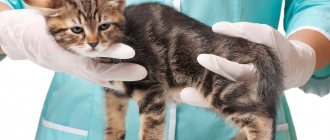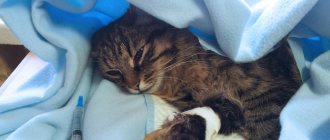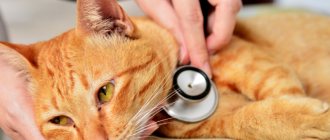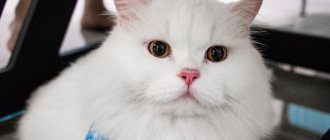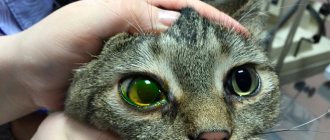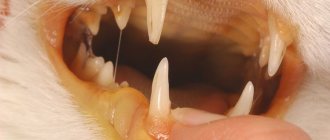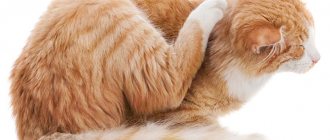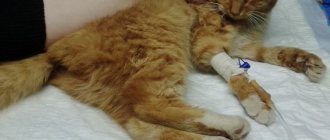- Symptoms of viral peritonitis in cats
- Diagnosis of viral peritonitis
- Treatment of viral peritonitis in cats
Peritonitis in a cat is a disease in which inflammation of the peritoneum (the membrane lining the abdominal cavity and covering the organs located in it) is observed.
The condition is extremely dangerous for the health and life of the animal. Diagnosing the disease accurately and on time is difficult. The mortality rate from it is quite high, even if timely qualified veterinary care is provided. Therefore, it is possible to protect a cat from peritonitis by preventing the development of this disease. The coronavirus is transmitted through nutritional means, through contaminated feces. When infected through the oral or nasal cavity, the process of virus entry occurs in the epithelial cells of the pharynx, respiratory tract or intestines. Most infections at this stage will not produce symptoms. Signs of mild to severe enteritis may occur.
Factors influencing the development of the pathological process of a cat infected with coronavirus:
- Strain - there are strains of different virulence
- Dose-infection with the virus at higher titers increases the risk of developing peritonitis
- Stress - any stress provokes the onset of the development of a pathological process
- Genetically determined susceptibility
Description of the disease
Viral peritonitis in cats develops against the background of a mutation of the coronavirus. Its exact mechanism is unknown. It is usually triggered by stress.
When infected with coronavirus, there are no obvious signs of infection. In some cases, kittens or weakened adults develop intestinal upset.
Infectious peritonitis in cats occurs in two forms:
- Wet (exudate) - viscous, light yellow liquid accumulates in the pleural (chest) or abdominal cavity.
- Dry – internal organs are affected by granulomatous (nodular) pathological changes.
Both forms lead to the death of the animal. The disease most often occurs in kittens and adults under 3 years of age, as well as older cats over 10 years of age. The likelihood of developing viral peritonitis does not depend on the sex of the animal. Outbred cats are most susceptible to the disease.
Owners of pets with viral peritonitis should not be afraid: the infection is not transmitted to humans. But for other cats, an infected animal is extremely dangerous.
Diagnosis of viral peritonitis
Only an experienced specialist can make an accurate diagnosis. For this purpose the following events will be carried out:
- a thorough visual examination of the animal;
- palpation of the abdominal cavity;
- temperature measurement;
- taking effusion for analysis;
- blood tests;
- biopsy;
- if necessary - ultrasound, x-ray, diagnostic laparoscopy.
Before making a diagnosis, the veterinarian will take a detailed medical history. For an accurate diagnosis, it is important to know the living conditions of the animal, the presence of gastrointestinal disorders in the near future, severe stress, and contacts with other pets. The acute form of the pathology can also be provoked by surgical intervention.
Causes
Coronavirus is an RNA virus. It is large, spherical in shape with club-shaped processes resembling a crown. It was they who gave it its name.
The virus multiplies in the animal's intestines. It can survive in the environment for about a month and is insensitive to cold. Coronavirus is destroyed at high temperatures and does not survive in light.
The virus, entering the cat’s body, does not manifest itself in any way. After a month or two, the animal becomes ill, but remains a source of infection. The pathogen is found in cat feces and nasal secretions.
Coronavirus
Viral leukemia
Cat rabies
Infection occurs through the oral route, less commonly through airborne droplets.
At risk are cats living in crowded conditions (kennels, animal hotels). Kittens become infected from their mother either in the womb or through licking.
The mechanism of coronavirus mutation leading to the development of infectious peritonitis is not fully understood. Possible factors provoking it:
- Decreased animal immunity.
- Stress caused by moving or adding another pet to the house.
- Age-related nervous and mental disorders.
In some cases, a change in food became a trigger for mutation.
How does peritonitis develop?
The mutated virus infects macrophages (cells responsible for destroying infections). It multiplies in them and is transported throughout the body by the bloodstream. In cats with high immunity, infectious peritonitis does not develop; the virus dies.
If the body is weakened, the virus begins to win. The immune system produces defective antibodies. They, interacting with the virus and blood proteins, form compounds that are attached to the walls of blood vessels. Which leads to their damage. Protein fluid from the vessels flows into the abdominal or pleural cavity, where it accumulates. Within a few weeks the cat dies.
When there is an immune response, but it is not sufficient to destroy the virus, a dry form of infectious peritonitis occurs.
The mutated virus is not contagious to other cats. When they come into contact with a sick animal, they become infected with coronavirus.
Predictions for the animal
The wet form of VIP is more severe: the prognosis for life is always unfavorable: only 6-7 months. The dry variety, with proper care, allows cats to live a couple of years longer, but such data is also not entirely indicative: in cats with this form of infection, repeated tests showed a negative antibody test result - the cat was probably already at the “healing” stage at the time the first ones were taken analyses.
global $ads_google; //data-ad-slot=”2475549904″ $ads_google = empty($ads_google) ? false : true; ?> if ($ads_google == false) {?>
$ads_google = true; ?> } ?>
If you quickly remove the effusion fluid, the disease can turn into a dry form.
Symptoms
Symptoms of viral peritonitis in cats appear abruptly. Common to the two forms:
- Increased body temperature, chills.
- Decreased appetite.
- Weight loss.
- Anemia.
- Apathy.
In the wet (effusive) form of peritonitis with the accumulation of fluid in the abdominal cavity, the cat’s abdomen increases in volume. It becomes difficult for the animal to walk. When a cat jumps from a small height, a characteristic sound is heard, as if a bag of water fell on the floor.
With effusion into the pleural cavity, breathing becomes difficult. The cat snores and sniffles. The animal develops shortness of breath. Over time, it becomes more difficult for him to walk.
Adult pets spend more time lying down and show little interest in what is happening. In kittens, periods of activity and attempts to play alternate with lethargy and weakness.
In the dry form of infectious peritonitis, the symptoms depend on the burned organ system:
- Abdominal organs. Yellowing of the sclera, skin. Increase in the size of the kidneys, liver, pancreas. Their lumpiness.
- CNS, brain. Coordination of movements is impaired, convulsions and behavioral abnormalities are possible. Paralysis develops.
- Intestines. Regular upset bowel movements, vomiting.
- Eye. The color of the iris changes, and iritis (inflammation) develops.
When the skin is damaged, nodular neoplasms appear.
Forms of feline peritonitis
Not all owners of purring dogs are familiar with this disease; for many, it is just something like a horror story from a series of veterinary fairy tales. But, unfortunately, Feline Infectious Peritonitis, or FIP, is an insidious and real thing.
Cases of infection are gradually becoming more frequent, which is facilitated by the lack of control in breeding, if a stud cat and, at the same time, a carrier of the disease has many matings with meowing representatives of different catteries.
When faced with a disease for the first time, not everyone understands what exactly they are faced with; even a visit to the veterinarian does not always immediately clarify the picture.
The biological reasons for the degeneration of the insidious feline enteritis virus into the cruel pathogenic coronavirus of peritonitis have not been fully disclosed.
Viral peritonitis has two forms:
- dry;
- wet.
Wet form dry FIP
In weakened cats, the “wet” form is common, with the course of the disease ranging from a couple of weeks to several months. But this does not mean that the infection entered the pet’s body literally the day before: the period from the infection entering the body to the manifestation of the disease can last months or even years.
The wet form has a peculiarity: the body cavities, abdominal, thoracic, pericardial, near the scrotum, begin to fill with free liquid with a bright yellow color, viscous in consistency.
global $ads_google; //data-ad-slot=”2475549904″ $ads_google = empty($ads_google) ? false : true; ?> if ($ads_google == false) {?>
$ads_google = true; ?> } ?>
Externally, a swollen belly gradually becomes noticeable, with the pet’s overall weight loss. The ridge protrudes, the muzzle becomes haggard. The skin loses moisture, the skin changes color, becoming yellowish.
Late stages of wet FIP are characterized by an impressive-looking abdomen.
Non-infectious peritonitis
There is a concept of non-infectious peritonitis: this is a consequence of perforation of internal organs and the spilling of their contents into other cavities of the body, which causes suppuration with all the serious consequences. This type of peritonitis is resolved by surgery and is in no way associated with coronavirus.
Dry form wet FIP
global $ads_google; //data-ad-slot=”2475549904″ $ads_google = empty($ads_google) ? false : true; ?> if ($ads_google == false) {?>
$ads_google = true; ?> } ?>
In the dry variety, the symptoms are not so noticeable, although the nervous system suffers more. The body is affected in different tissues, which affects the manifestation of signs of the disease. Such affected lesions are called granulomas.
The body, in both wet and dry forms, steadily fades away, and the animal faces death.
Laboratory diagnostic methods
Coronavirus (not mutated) can be easily detected in cat feces and saliva. It is recommended to take tests twice, two weeks apart.
The mutant virus cannot be detected in the blood; the analysis will show the presence of antibodies to the coronavirus, but not its strain. A large number of antibodies (over 1200) can indirectly indicate a mutation. But only if there are symptoms of peritonitis.
Diagnosing viral peritonitis in cats is difficult; its symptoms coincide with other diseases. So the wet form is easily confused with bacterial peritonitis, cardiac or renal ascites. Dry - with lymphosarcoma, toxoplasmosis, tuberculosis.
To diagnose viral effusion peritonitis, ascites fluid is examined. An increased amount of protein in it (over 35 g/l) indicates the viral nature of the disease. A PCR test that detects the RNA of the virus will confirm the diagnosis.
To diagnose the dry form of peritonitis, ultrasound diagnostics are performed. The affected organs are enlarged in size, granulomas (nodules) and foci of necrosis are clearly visible on their surface. The disease will also confirm the presence of anemia in the animal, the hematocrit is below 30%.
What is peritonitis
global $ads_google; //data-ad-slot=”2475549904″ $ads_google = empty($ads_google) ? false : true; ?> if ($ads_google == false) {?>
$ads_google = true; ?> } ?>
In 1963, peritonitis was described for the first time, although the causative agent of the virus itself was identified only in 1977. But in 1981, enteritis or coronavirus was officially registered. It is noteworthy that cats can be infected by some strains of coronavirus that are characteristic of the canine body.
Feline coronaviruses are divided into feline infectious peritonitis virus (FIP) and strains that can only cause minor enteritis or do not pose a serious threat to the health of pets (FIP).
The only difference between both varieties is the ability to harm the cat’s body, but, nevertheless, VPK is a mutated strain of KKVK.
Treatment
There is no cure for infectious peritonitis in cats. You can alleviate your pet’s condition and delay death.
Treatment is symptomatic. The animal is prescribed courses of immunostimulants and antiviral drugs to reduce the activity of the virus. It is impossible to completely defeat him.
With effusion, cats lose minerals (especially potassium) and vitamins. Therefore, therapy is supplemented with multivitamins and potassium-sparing drugs. In some cases, corticosteroids and antibiotics are prescribed.
The veterinarian prescribes the exact treatment regimen. He also determines the duration of courses and dosage of medications.
In the wet form of viral peritonitis, the accumulated fluid is periodically pumped out. Intervention is resorted to when the cat becomes difficult to breathe and/or move.
There is also a downside to pumping. It brings significant temporary relief. But after the procedure, the liquid begins to accumulate even faster, and the pet’s body loses more and more potassium and vitamins. The animal is exhausted.
Instrumental examination
To identify damage to internal organs, the following is carried out:
- Ultrasound of the abdominal cavity (this allows you to detect granulomas, accumulated fluid and inflammation in the intestines);
- puncture of the womb (fluid from the abdominal cavity is studied, for this purpose it is taken);
- biopsy (during the biopsy, granulomas detected during ultrasound are examined);
- X-ray (allows you to detect the presence of fluid in the abdominal cavity).
Important! The cat is sent for x-ray if it shows shortness of breath, it is suffocating.
Is there a risk of getting infected from a sick animal?
There is a risk of infection from a sick animal, but it is minimized if contact between animals is short-term and minimal.
To avoid infection, it is enough to keep your pet away from street cats and do not let the animals lick each other. The risk of infection increases when animals use a common tray and bowl for food (drinking).
If animals simply passed by each other or are in adjacent cages (during transportation in the luggage compartment of an airplane, at exhibitions), it is almost impossible to become infected.
If we talk about the risk for the animal owner, then there is none. Despite frightening rumors, people do not get sick with cat viral peritonitis, even with close contact with their pet.

